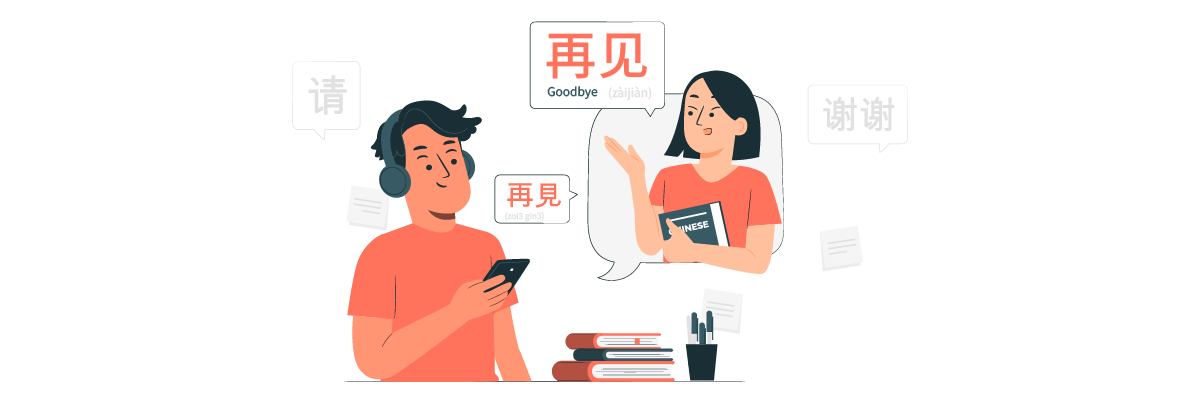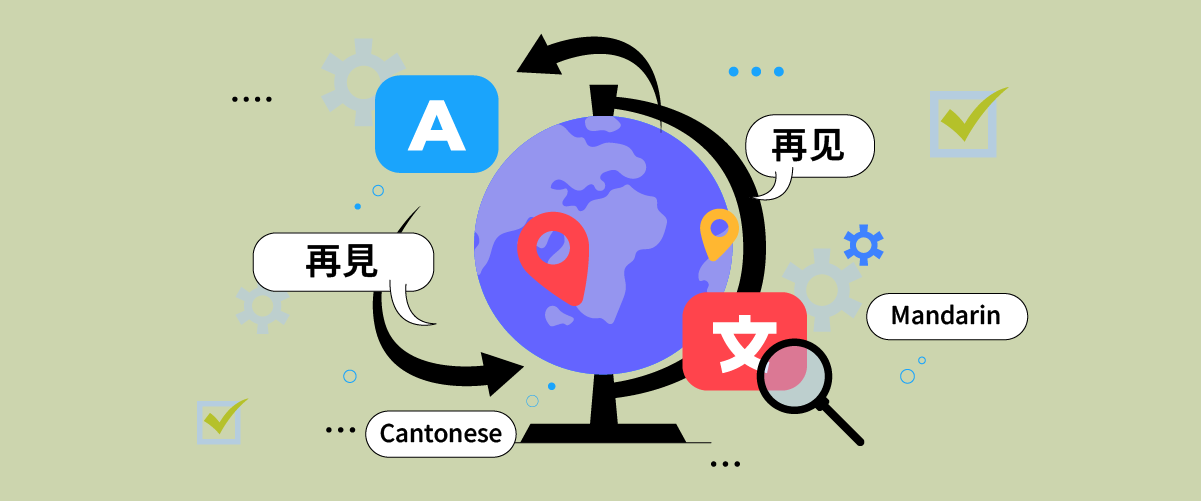Have you ever heard someone speak Chinese? It must be Mandarin, right? But did you know that besides Mandarin, other Chinese languages are also popular? That’s Cantonese! Although Mandarin and Cantonese are often grouped under “Chinese”, they are not mutually intelligible. Speakers of these two “dialects” may find it difficult to understand each other, even if they have the same written characters.
So, why are Mandarin and Cantonese considered part of the same language? This guide will outline the main differences between Cantonese and Mandarin. Let’s explore what sets Cantonese and Mandarin apart!
Cantonese vs Mandarin overview

Mandarin and Cantonese may seem like “two sides of the same coin” as they are considered “Chinese languages.” However, they are very different in pronunciation, usage, and even region of use. Mandarin is a superstar in the world. It has a total of 1.1 billion speakers and is one of the most spoken languages in the world. It is the official language of China, Taiwan, and Singapore, making it a top choice for cross-border communication. On the other hand, Cantonese is the soul and culture of places like Hong Kong, Macau, and parts of Southern China, with around 85 million Cantonese speakers worldwide.
The main difference between the two lies in pronunciation. Mandarin tends to be simpler, using four tones (plus a neutral tone), making it easier to learn for non-native speakers. In addition, Mandarin has a handy romanization system called Pinyin, which makes learning easier.
As for Cantonese? We think of it as a melodic language with six main tones plus three overtones.
While Mandarin and Cantonese speakers may not understand each other in spoken language, they can still connect through the same Chinese writing system. Beyond that, there are a few other differences between these two languages, which we’ll discuss further!
Key Differences between Cantonese vs Mandarin
After discussing the differences between Cantonese and Mandarin in general, we will discuss some differences further, looking at several factors.
Geographical distribution

When it comes to Chinese, we often hear Mandarin, right? Mandarin is like a pop star in China. Almost everyone there understands it, from Beijing to Taiwan. Even the United Nations has Mandarin as one of its official languages!
Whereas, Cantonese is like the language of cool kids in south China. It’s especially popular in Guangdong, Hong Kong and Macau. Despite its smaller area, it has a huge influence. Many Chinese people are living abroad, especially in areas that used to be British colonies, like Malaysia or Singapore, and they often use Cantonese. How cool is that?
An interesting fact is that Guangdong is the most populous province in China with over 127 million population in 2023. So, it’s no surprise that Cantonese is one of the most spoken languages in the world.
Pronunciation and tones

Pronunciation is the biggest difference between Cantonese and Mandarin. Mandarin, China’s official language, underwent centuries of tone simplification. As a result, Mandarin has only four main tones (plus one neutral tone), making it easier for new speakers to learn.
In contrast, Cantonese, widely spoken in regions such as Hong Kong and Guangdong, has retained a more complex tonal system, totaling nine. Therefore, in Cantonese, small differences in intonation-such as the rise or fall of a tone-can make a huge difference.
Here are the differences in pronunciation and tone in both Mandarin and Cantonese.
Mandarin (4-5 tones):
- Tone 1: High and flat (ā) – example: 妈 (mā) “mother”
- Tone 2: Rising (á) – example: 麻 (má) “hemp”
- Tone 3: Down then up (ǎ) – example: 马 (mǎ) “horse”
- Tone 4: Sharp descending (à) – example: 骂 (mà) “scold”
- Neutral tone (a) – example: 吗 (ma) [question particle]
Cantonese (9 tones): Open Syllaba (6 tones):
- High level/high falling: 詩 (si1) “poetry”
- High rising: 史 (si2) “history”
- Mid-level: 試 (si3) “try”
- Low falling: 時 (si4) “time”
- Low rising: 市 (si5) “market”
- Low level: 事 (si6) “thing”
Plus 3 extra tones for closed syllables (-p, -t, -k):
- High level entering
- Mid-level entering
- Low level entering
From the various tones above, we can conclude that Cantonese is slightly more complicated than Mandarin, which is often considered complicated enough to learn and understand.
Characters

Mandarin generally uses simplified characters, implemented in China in the mid-20th century as part of language reforms to increase literacy rates nationwide. These reforms reduced the number of strokes in many characters, making Mandarin easier to learn and write, especially for new learners.
In contrast, Cantonese, widely used in Hong Kong, Macau, and some communities in Guangdong, retains more elaborate traditional characters. These traditional characters reflect a strong cultural heritage, with more strokes and an aesthetic considered more elegant and formal.
Aspects | Mandarin | Cantonese |
Kind of character | Simplified Chinese | Traditional Chinese |
Romanization System | Pinyin | Jyutping |
Interestingly, Cantonese has some unique characters not found in standard Mandarin, reflecting local linguistic and cultural needs. For example, the character 佢 (keoi5), meaning “he,” does not exist in Mandarin, which uses 他 (tā) for male “he,” 她 (tā) for female “she,” and 它 (tā) for objects or animals. Another example is 喺 (hai2), meaning “to be at,” which also has no direct equivalent in Mandarin, where the concept is often expressed with 在 (zài).
This difference reflects linguistic differences and creates striking variations in writing. For example:
Simplified (Mandarin) vs Traditional (Cantonese)
- 我爱你 vs 我愛你 (I love you)
- 学习 vs 學習 (Study)
- 电脑 vs 電腦 (Computer)
As you can see, Cantonese character writing looks more stroke-dense and a bit more complicated than Mandarin, which is simpler nowadays.
Vocabulary and grammar

The next difference between Cantonese and Mandarin can be seen in the vocabulary and grammar. Although the basic sentence structure of Mandarin and Cantonese is the same ( Subject + Predicate + Object pattern), some aspects have important differences. In addition, there are some differences in grammar, such as.
Adverb order
- Mandarin: Adverb before the verb
- Cantonese: Adverb after the verb
Example:
“You go out first”
- Mandarin: 你先出去 (nǐ xiān chū qù)
- Cantonese: 你出去先 (nei5 ceot1 heoi3 sin1)
Double-object
- Mandarin: Indirect object before direct object
- Cantonese: Direct object before indirect object
Example in Mandarin:
Structure: Subject + Verb + Indirect Object + Direct Object
我给 我的朋友一本书
(I) (give) (my friend) (one book)
Breakdown:
- 我 (wǒ) = I
- 给 (gěi) = Give
- 我的朋友 (wǒ de péngyǒu) = My friend (indirect object)
- 一本书 (yì běn shū) = One book (direct object)
Example in Cantonese:
Structure: Subject + Verb + Direct Object + Indirect Object
我畀本书 我个朋友
(I) (give) (book) (my friend)
Breakdown:
- 我 (ngóh) = I
- 畀 (bei2) = Give
- 本书 (bún syū) = Book (direct object)
- 我个朋友 (ngóh go pàhngyáuh) = My friend (indirect object)
In addition, there are some vocabulary differences between the two languages, here are some different everyday vocabulary.
Meaning | Mandarin | Pinyin | Cantonese | Jyutping |
Eat | 吃 | chī | 食 | sik6 |
Beautiful | 美 | měi | 靚 | leng3 |
Look | 看 | kàn | 睇 | tai2 |
Tomorrow | 明天 | míng tiān | 聽日 | ting1 jat6 |
Those are some differences between Cantonese vs Mandarin when viewed from several factors. Here is a table of differences to make it easier to understand.
Factors | Mandarin | Cantonese |
Geographical distribution | The official language in China, spoken nationwide from Beijing to Taiwan. Recognized by the UN as an official language | Primarily spoken in Guangdong province, Hong Kong, and Macau. Popular among the Chinese diaspora in former British colonies like Malaysia and Singapore |
Pronunciation and tones | 4-5 tones (4 main tones + 1 neutral tone) | 9 tones (6 syllable open tones + 3 additional closed syllable tones) |
Characters | Simplified Chinese characters | Traditional Chinese characters |
Vocabulary and grammar |
|
|
Simplify multilingual communication with automatic translation

If your business is targeting the Chinese market, it’s important to understand that simplified Mandarin and traditional Cantonese are spoken in the country. Providing both ensures you reach a wider audience and shows your seriousness in understanding local needs.
To ease this process, you can use Linguise automatic translation, a smart solution that supports more than 80 languages, including Chinese simplified and Chinese traditional. With Linguise, you can save time and resources while ensuring that your messages are delivered accurately, regardless of the language’s linguistic complexity.
Conclusion
Now you know the difference between Cantonese and Mandarin. While both are considered “Chinese,” their distinctions span pronunciation, tones, characters, and grammar. Mandarin’s simplicity, with its four tones and simplified characters, makes it accessible and widely used internationally. Meanwhile, Cantonese retains its melodic complexity with nine tones and traditional characters, reflecting a rich cultural heritage that dominates regions like Hong Kong and Guangdong.
Understanding these differences is crucial for businesses targeting the Chinese market. By offering content in both Mandarin and Cantonese, you ensure a broader reach and cultural relevance. Simplify the process with Linguise. Create a free Linguise account today and take the first step toward seamless multilingual communication!




